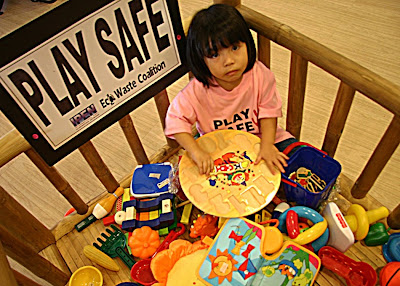EcoWaste Coalition's Study Bares Toxic Ingredients in Children's Products

EcoWaste Coalition’s Study Bares Toxic Ingredients in Children’s Products
(as FDA endorses research survey, enjoins industry to produce toxic-free products)
20 July 2011, Quezon City. A toxic watchdog today released the results of the first ever public investigation of toxic metals in children’s products such as toys, cosmetics and accessories in the Philippines.
At a press conference held in Quezon City, the EcoWaste Coalition through its “State of the Toys Analysis” (SOTA) revealed that 30% of the 200 imported, as well as locally-made, children’s products bought from a variety of shops and locations in Metro Manila tested with at least one toxic metal above levels of concern.
However, some 70% of the products did not contain toxic metals (or contained low levels of them), indicating the technical feasibility of manufacturing safe products that do not expose children to toxic metals, the group reported.
The chemical analysis conducted by the EcoWaste Coalition in collaboration with the International POPs Elimination Network (IPEN) shows that antimony, arsenic, cadmium, chromium, lead and mercury can be found in toys and other children's products for sale in bargain stores in Baclaran and Divisoria, "ukay-ukay" shops and even in giant shopping malls in the metropolis.
The findings were disclosed ahead of the “State of the Nation Address” (SONA) by President Benigno Aquino III in the hope of pushing the government to adopt the protection of children from harm posed by toxic substances as a priority goal.
Of the 200 samples, 37 products (19%) were found in violation of the US regulatory limit for lead, a neurotoxin with no safe level of exposure, with values ranging from 90 parts per million (ppm) to over 12,000 ppm.
The lead-tainted products included a variety of cars and dolls, fake food items which invited chewing, cosmetics that are applied directly to the skin and floor matting which commonly used to cushion areas where infants play.
The study also found three children's cosmetic products containing mercury, another notorious neurotoxin, at levels significantly higher than the regulatory limit in the Philippines of 1 ppm, ranging from 4 to 77 ppm. The products included lipstick and eye shadows designed to be applied directly to the lips and skin.
Visiting American scientist Dr. Joseph Di Gangi conducted the tests from July 17 to 19, 2011 using a portable X-Ray Flourescence (XRF) analyzer that is widely used by the private sector and regulatory agencies such as the US Environmental Protection Agency and the Consumer Product Safety Commission.
“The findings raise valid safety concerns for toxic exposure among children and send a strong signal to the toy industry to shape up, phase out harmful chemicals in their products and shift to safer ingredients,” stated DiGangi, IPEN Science and Policy Adviser.
For his part, Thony Dizon, Coordinator of the EcoWaste Coalition’s Project Protect appealed to the business community not to engage in production, trade and sale of toys and other children’s products containing toxic metals and other injurious substances such as those listed on the “Priority Chemical List” of the country.
The effort of the EcoWaste Coalition and IPEN to generate data and seek industry reforms drew immediate support from the Food and Drug Administration (FDA), the lead agency that regulates toys and other children's products.
In a statement read by her representative, Dr. Suzette Lazo, FDA Director, said that the agency “continues to work towards strengthening its capability and processes consistent with its relentless quest to achieve toxic-free products.”
“Recognizing the vital role of non-government organizations (NGOs), the FDA acknowledges every effort including activities that can aid the agency in establishing data to justify regulatory actions,” she stated.
“The FDA, thus, endorses initiatives of EcoWaste Coalition and IPEN, both NGOs, in conducting a research survey on the presence of toxic elements in consumer products especially those critical to vulnerable groups of the society such as children,” Dr. Lazo said.
Dr. Lazo also noted “the availability of breakthrough technology that can quickly and accurately test for the presence of harmful chemicals such as lead, mercury, cadmium, chromium and arsenic in consumer products can significantly boost monitoring efforts and prevent unsafe products from being marketed to unsuspecting consumers.”
“The FDA hereby enjoins every manufacturer, importers, distributors and retailers to be more aware of safety issues and to exercise extraordinary diligence in their manufacture and distribution of products under their stewardship by assuring that these are free of harmful chemicals,” she stressed.
The FDA further encouraged consumers to be more vigilant and report to the agency at telephone number 8078275 or the nearest DOH-Center for Health Development (CHD) or the Health Offices of Local Government Units (LGUs) any product suspected to be hazardous to health for appropriate action.
Link to the report:
http://ipen.org/toxicproducts/
-end-






Comments